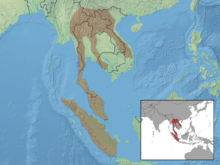Large bamboo rat
| Large bamboo rat | |
|---|---|

| |
| Scientific classification | |
| Domain: | Eukaryota |
| Kingdom: | Animalia |
| Phylum: | Chordata |
| Class: | Mammalia |
| Order: | Rodentia |
| Family: | Spalacidae |
| Genus: | Rhizomys |
| Species: | R. sumatrensis
|
| Binomial name | |
| Rhizomys sumatrensis (Raffles, 1821)
| |

| |

The large bamboo rat, Sumatran rat, or Indomalayan rat (Rhizomys sumatrensis) is a species of rodent in the family Spalacidae found in Cambodia, China, Indonesia, Laos, Malaysia, Myanmar, Thailand, and Vietnam. It is one of four species of bamboo rat. Individuals can reach lengths of nearly 50 cm (20 in) with a 20 cm (7.9 in) tail, and weigh up to 4 kilograms (8.8 lb).
Their typical diet includes bamboo roots, but they also feed on cultivated tapioca and sugarcane. They are, in turn, hunted as food by human beings.[1]
The species is a natural host for the disease-causing mold, Penicillium marneffei.[2][3]
It is one of several species of large rats that have been identified by scholars of Sherlockiana as the original model for the mysterious Giant Rat of Sumatra alluded to in a fictional story by Sir Arthur Conan Doyle.[4][better source needed]
References[edit]
- ^ Aplin, K. "Rhizomys sumatrensis". IUCN Red List of Threatened Species. Retrieved 10 April 2013.
- ^ Common Reservoirs for Penicillium marneffei Infection in Humans and Rodents, China
- ^ Ajello, L; Padhye, AA; Sukroongreung, S; Nilakul, CH; Tantimavanic, S (1995). "Occurrence of Penicillium marneffei infections among wild bamboo rats in Thailand". Mycopathologia. 131 (1): 1–8. doi:10.1007/bf01103897. PMID 8532047. S2CID 20573325.
- ^ The Sumatran Devil

